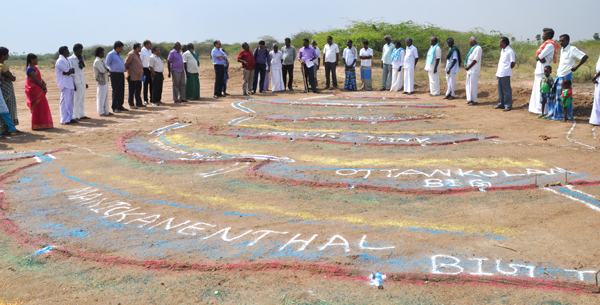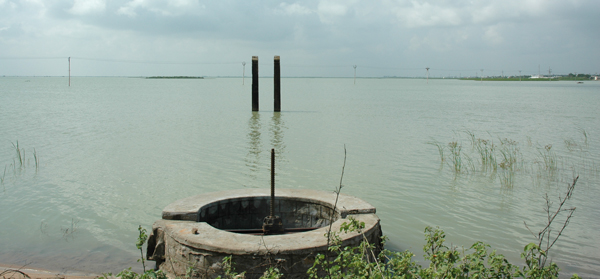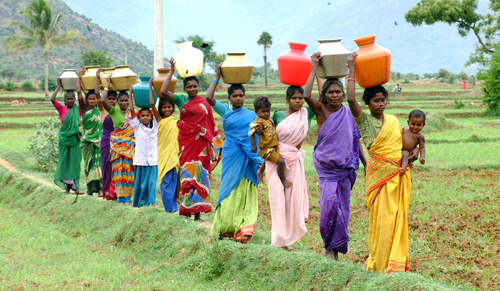
Case2-September-2017

South Asia is considered to be highly vulnerable and susceptible to the environmental changes amidst monsoon vagaries, natural disasters such as cyclones, floods and droughts, because of its large population, predominance in agriculture and limited resource base. As the globe faces continuous threats from the Climate Change Phenomenon, the irrigation sector will be affected to a large extent and thereby needs changes in the effectiveness of irrigation methods. The UNFCC framework has predicted increased variability of precipitation, which includes longer drought periods, would lead to an increase in irrigation requirements, even if the total precipitation during the growing season remained the same. Hitherto, wherever precipitation increases significantly during the growing period (due to climate change), net irrigation requirements could decrease. The overall irrigation demands could become even higher. Hence, water storage is considered more important in the future to conserve the flood waters obtained from intensified rains due to climate change.
Small and medium reservoirs offer considerable scope to adapt to the climate change so that agricultural biodiversity and ecosystems could be sustainably conserved. During floods, they offer scope to store the excess water, and allow for both irrigation and groundwater recharge during times of water shortage. As these reservoirs are distributed across the landscape, they capture more of the water, and provide more local control compared to a few large reservoirs.
| No. | States | No. of tanks | % of total tanks | 1990-91 Area irrigated(m.ha) | 2008-2009 Area irrigated | % area decline in 18 years |
|---|---|---|---|---|---|---|
| 1 | Andhra Pradesh | 60,745 | 29.15 | 0.97 | 0.84 | 13.40 |
| 2 | Karnataka | 20,152 | 9.67 | 0.24 | 0.21 | 12.5 |
| 3 | Maharashtra | 12,539 | 6.02 | 0.31 | 0.28 | 9.68 |
| 4 | Tamil Nadu | 39,366 | 18.89 | 0.53 | 0.49 | 7.5 |
| 5 | Sub-total | 1,32,802 | 63.73 | 2.05 | 1.82 | 11.22 |
| 6 | Other states | 75,579 | 36.27 | 1.19 | 0.65 | 45.38 |
India has an extensive network of existing small and medium reservoirs, called tanks, some dating back to centuries. The experience from irrigation tanks and water harvesting structures, illustrates both the potentials and challenges of this adaptation response as resilience building. Although, there are over 208,000 tanks in India, irrigating about 2.3 m.ha., the net area irrigated by tanks has declined by 27% between 1990-91 and 2009- 10. This article will cover the challenges being faced by tank irrigation and examines options for improving their performance such as revenue mobilisation through multiple use of tanks, augmenting groundwater resources in the tanks, tank sluice management, integrating social forestry and desilting, and tank modernisation, to enable these systems to meet increasing needs for water storage under climate change and resilience building. Since small and marginal farmers account for majority of tank farmers and cultivate about 70% of the lands in the tank irrigation systems, sustaining the tank irrigation potential is highly warranted.

DHAN Foundation is working towards water resource development with a community-owned approach using the nested people institutions model to build a resilient community, particularly the small and marginal farmers against the risks and vulnerabilities caused by climate change and other issues. DHAN has evolved innovative practices through its 25 years of experiences with the community to identify the interventions, test them in the field and then scale up the resilience building for sustainable development of the rural community for their livelihoods and other needs.
DHAN has created more than 4700 Vayalagams, 250 cascades and 35 federations at block and district levels for sustainable development of small and marginal farmers in the drought-prone regions of Deccan plateau in peninsular India and also in some hotspots of North India. These nested institutions would keep the life time agenda in its course for addressing the risks and vulnerabilities against the climate change and other issues.
These nested institutions play a critical role in resilience building with the community and other stakeholders. Collective action strives to bring back regular maintenance through the community for repairs and renovation, which is the best practice of resilience for a sustainable tank system. This practice insulates the system against flood risks during the rainy season.
Creating endowment for the water bodies helps regular fund maintenance by the community without expecting support. DHAN has created more than 500 endowments for Rs.10 million from CSR funding and another Rs. 10 million from the community.
Adaptation practices by the community in adopting silt application, crop diversification, mulching, organic agriculture practices, composting, pipeline irrigation, Neerkatti system of irrigation, System of Rice Intensification (SRI) and others through grant and loan-based products have been proven as resilient tools in water management.
DHAN is implementing the water resource development based on the river basin approach at macro and micro scales of watershed and tank levels for addressing the risks and vulnerabilities to create a resilient community for sustained use of water resources. A targeted water management tool has been adopted for more water per drop approach with basin level thinking and micro watershed and tank level implementation of the plan in a comprehensive way.
The traditional water managers (Neerkattis system) is one of the age-old traditional systems to keep the watch and ward on water bodies and also to create an effective and efficient water use system for tank irrigation to ensure sustainable agriculture and also resilient structures against the flood and cyclone related risks. Traditional water manager system revival implemented by DHAN is one of the effective methods of resilient water bodies in the villages as flood and drought moderator for protection of villages and its community.
DHAN has renovated more than 300 village ponds in peninsular India for addressing the issues of drinking water in the drought-prone regions of non-perennial river basin systems. Ramanathapuram, Pudukottai, Tuticorin, Kanchipuram, Thiruvallur, Sivaganga, and Madurai face acute drinking water problem during summer and other parts of the year. Renovating drinking water pond as an innovative resilient practice aids local solutions to address drinking water problems in a sustainable manner.

Heavy downpour during a few rainy days is a phenomenon caused by climate change. It necessitates more water harvesting structures to augment the water storage. While the tanks serve irrigation needs of the farmers in the entire command area, creation of farm ponds ranging from 500 cubic metres depending on the needs would supplement the irrigation needs of each farm, creating space for the farmers to adopt diversified cropping as fodder production for livestock, raise vegetable crop on its bunds and for fish rearing.
DHAN has supported creation of over 5000 farm ponds in the farmers’ fields to provide life-saving irrigation to crops during the critical phases of water need, thereby securing their livelihoods. A properly integrated farm pond could act as the most critical shock absorber for the farmers to sustain the farm interventions.
An individual tank with its own catchment, water spread and command area is an integral part of a watershed within which it is situated. A cascade of tanks is a micro watershed by itself as the tanks are interlinked, often by a common stream or by the surplus water of an upper tank feeding a lower one. An existing tank or cascade of tanks within a watershed captures the rain water runoff and conserves it for later use, which would otherwise flow down the gullies and streams and mostly get evaporated or otherwise dissipated. Over the last two decades DHAN has been constantly advocating inclusion of tanks in the conventional watershed treatment plan. Started on pilot basis in Chittoor district of Andhra Pradesh in 1997, the tank-based watershed model demonstrated its impact, which has encouraged the government to include it in the revised guidelines for watershed. DHAN has taken up Watershed Development work in 104 watersheds under various central and state government schemes benefiting another 75,900 hectares of land through soil and moisture conservation practices. This is proven as one of the best ecosystem approaches and a resilient practice demonstrated at various parts of the country by DHAN Foundation during the last 25 years.
DHAN has demonstrated tree plantation as one of the effective interventions to create green cover and micro environment at the micro watershed level at 104 watersheds. Every year, not less than lakhs of tree plantation is done at watershed project implementation areas as a climate resilient product in the remote watersheds.
DHAN’s Vayalagam model of water resources management with sustainability perspective has created resilient water resources development in resource poor and resource rich agro-climatic conditions. As an ecosystem approach, it addresses poverty and creates community resilience against the risks and vulnerability due to climate change and other issues.